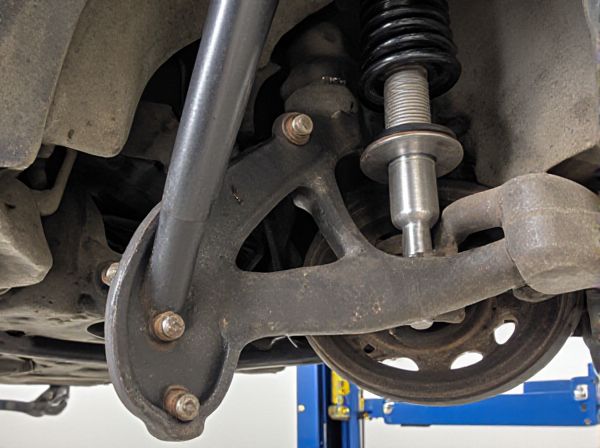
Photo illustration: MacPherson Strut vs Double Wishbone
MacPherson struts offer a compact, cost-effective suspension design commonly used in front-wheel-drive vehicles, optimizing space and reducing weight. Double wishbone suspensions provide superior handling and ride comfort by allowing precise control of wheel motion and camber, ideal for performance-oriented cars. Your choice depends on whether you prioritize affordability and simplicity or enhanced handling and stability.
Table of Comparison
| Feature | MacPherson Strut | Double Wishbone |
|---|---|---|
| Design | Single control arm with integrated shock absorber and coil spring | Two control arms (upper and lower) with separate shock absorber and spring |
| Space Efficiency | Compact, saves space, ideal for front suspension in compact cars | More space-consuming due to complex arm layout |
| Ride Comfort | Moderate, suitable for general driving conditions | Superior, allows better absorption of road irregularities |
| Handling Performance | Good for everyday driving, less precise in cornering | Excellent, enhances stability and precise wheel control |
| Cost | Lower manufacturing and maintenance costs | Higher costs due to complexity and parts |
| Durability | Simple design leads to fewer failures but limited adjustability | Robust design with adjustable geometry for performance tuning |
| Common Use | Economy and compact cars | Sports cars, luxury vehicles, and performance applications |
Introduction to Suspension Systems
MacPherson strut suspension combines a shock absorber and coil spring into a single, compact unit, offering simplicity and cost-effectiveness for many vehicles. Double wishbone suspension features two control arms per wheel, providing improved handling, ride comfort, and precise wheel alignment under dynamic conditions. These fundamental designs influence vehicle stability, tire wear, and overall road performance in distinct ways.
What is a MacPherson Strut?
A MacPherson strut is a type of car suspension system that combines a shock absorber and a coil spring into a single, compact unit, providing both damping and structural support. It is widely used in front-wheel-drive vehicles due to its simplicity, low cost, and space-saving design, which allows for more room in the engine bay. Compared to the double wishbone suspension, the MacPherson strut offers easier manufacturing and maintenance but typically sacrifices some handling precision and ride comfort.
What is a Double Wishbone Suspension?
A Double Wishbone suspension consists of two parallel arms, shaped like wishbones, that connect the wheel hub to the vehicle's chassis, allowing precise control over wheel motion and alignment. This design enhances handling, stability, and ride comfort by maintaining consistent tire contact with the road during cornering and uneven surfaces. Compared to MacPherson struts, Double Wishbones provide superior camber control and suspension geometry, making them preferred in sports cars and performance vehicles.
Key Differences: MacPherson Strut vs Double Wishbone
MacPherson strut suspension features a single lower control arm and a combined shock absorber and coil spring unit, optimizing space and cost efficiency in front-wheel-drive vehicles. Double wishbone suspension employs two separate control arms per wheel, providing enhanced wheel control, improved handling, and better camber adjustment during cornering. The MacPherson strut is simpler and lighter, while the double wishbone offers greater stability and precision, especially in high-performance and off-road applications.
Ride Comfort and Handling Comparison
MacPherson strut suspension offers a simpler, more compact design that prioritizes ride comfort by providing a smooth and compliant ride over rough surfaces. Double wishbone suspension delivers superior handling through precise wheel control and better camber maintenance during cornering, enhancing overall vehicle stability. While MacPherson struts favor comfort and cost-effectiveness, double wishbones excel in performance driving scenarios requiring sharper responsiveness and improved road grip.
Space and Packaging Considerations
MacPherson strut suspension requires less lateral space due to its compact design, making it ideal for front-wheel-drive cars and limited engine bay environments. Double wishbone suspension offers superior wheel control but demands more room for upper and lower arms, complicating packaging in tight compartments. Vehicle architects often choose MacPherson struts to optimize cabin and engine bay space while sacrificing some dynamic performance achievable through double wishbone setups.
Cost and Maintenance Factors
MacPherson strut suspension systems are generally more cost-effective due to their simpler design and fewer components, resulting in lower initial manufacturing and replacement costs. In contrast, double wishbone setups involve more complex parts and precise alignment, increasing both the purchase price and maintenance expenses. Maintenance for MacPherson struts is typically less intensive and cheaper, while double wishbones, though offering superior handling, require more frequent inspections and costly repairs.
Application in Modern Vehicles
MacPherson strut suspension is widely used in modern vehicles due to its compact design, cost-effectiveness, and suitability for front-wheel-drive configurations, making it common in economy and mid-range cars. Double wishbone suspension offers superior handling and ride quality with better control over camber angles, favored in sports cars, luxury vehicles, and off-road SUVs that prioritize performance and precise steering. Manufacturers often select MacPherson struts for mass-market models aiming for space efficiency and lower production costs, while double wishbones are employed in vehicles requiring enhanced stability and dynamic driving characteristics.
Pros and Cons of MacPherson Strut
The MacPherson strut suspension offers a compact and cost-effective design, making it ideal for front-wheel-drive vehicles with limited space. It provides good ride comfort and steering responsiveness but has limitations in controlling camber changes during cornering compared to double wishbone setups. Its simplicity results in fewer components, reducing maintenance costs, but compromises on handling precision and wheel alignment adjustability found in more complex suspension systems.
Pros and Cons of Double Wishbone
Double Wishbone suspension offers superior handling and stability due to its ability to maintain optimal tire contact with the road, enhancing cornering performance and ride comfort. It provides greater control over camber angle compared to MacPherson Strut systems, resulting in less tire wear and improved traction during aggressive driving. However, Double Wishbone setups are more complex, heavier, and costly to manufacture and maintain, often requiring more space which can limit design flexibility in smaller vehicles.
 caratoz.com
caratoz.com